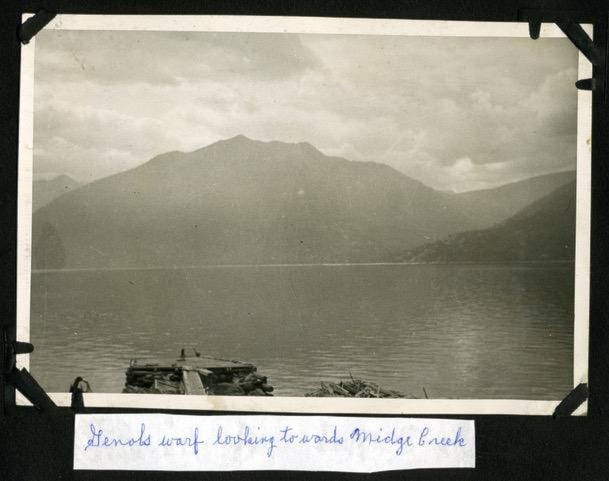A series on West Kootenay/Boundary place names
GOOSE CREEK AND NEW SETTLEMENT
Goose Creek flows into the Slocan River at Crescent Valley and is also used as a community name. Its boundaries are ill-defined, but it includes the area along Pass Creek Road from just south of Spur Road (a dividing line for school districts and the telephone exchange) until it swings around at Crescent Valley past Westwind Road. The creek name was officially adopted in 1955.
And what’s good for the goose is … well, you know. Nearby Gander Creek was adopted in 1959.
At the junction of the two creeks is New Settlement, known as Novoye Posleniye or Novoy Poselok in Russian. It consists of the areas along Sorokin and Reservoir Roads, off Pass Creek Road.
According to Jonathan Kalmakoff’s Doukhobor Gazetteer: “In 1971, Sons of Freedom established the New Settlement … The unincorporated community flourished until 1987, when the lands were foreclosed upon by the Crown for non-payment of taxes. From 1989 to 1995, the Crown subdivided the lands and sold the lots back to individual residents. A portion of the lands is held in trust by the Bozhiya Zemlya (God’s Land) society.”
The Freedomites who formed New Settlement were returning from Agassiz, where 500 of them marched in 1963 to join 100 others being held in a special prison. However, they regarded Russia as the old settlement, not Agassiz.
New Settlement is recognized as a community by the BC Geographical Names office. The name became official in 1986.
GINOL’S LANDING
This spot near Boswell on Kootenay Lake’s East Shore was named for husband and wife William (1860-1934) and Emma Eudora Ginol (1859-1945).
William was a miner-turned-fruit farmer who immigrated from Switzerland to Canada in 1892. He was first mentioned in our area as locating the Bee claim in the Ainsworth mining division in 1897. By the following year he was on the East Shore, working on White Grouse mountain. In 1902, he married Emma Turner, former proprietor of hotels at Pilot Bay and Sanca.
Jessie Hepher recalled in Kootenay Pathfinders: “Mrs. Ginol was somewhat strange to my palate. She was one of those deceptively fragile looking women, extremely capable with a will of iron. I was vastly entertained by her story of the theft of her carpets from her hotel in Sanca … She correctly identified the culprits and raised such a storm that they were happy to restore the carpets and retreat rapidly!”
In the same book, Ted Affleck wrote that when Earl Grey, Canada’s governor general, visited the area in 1906, he was “treated to some of Mrs. Ginol’s efficient hospitality, no doubt tempered by her US midwest twang and her militant republican/egalitarian outlook.”
Earl Grey bought some land for his son which became the Boswell ranch and hired the Ginols as caretakers. According to Gray Creek’s Tom Lymbery, the Ginols had their own fruit ranch and stone wharf just north of today’s Glass House.
“Mrs. Ginol was apparently a person who stood on her rights and had an ongoing battle to get the Nasookin to call at Ginol’s Landing. The story says that she actually fired a shot across the bow of the boat.
“I think the Ginols had the last phone on the single line grounded circuit magneto that was built along the shore from Pilot Bay in 1915. It only went as far as Sanca. My mother, Kathleen Lymbery, answered our phone one day and a man said ‘Ginol speaking’ and her reply was ‘No, I don’t.’”
Ginol’s Landing first appears in the 1922 BC civic directory as “a landing reached by steamer on Crow’s Nest route, Nelson to Kootenay Landing,” but no residents are listed.
The first newspaper mention was in the Creston Review of May 15, 1925: “Dr. Henderson had a hurried call to Ginol’s Landing on Monday morning due to Mr. W. Mack, who resides there, having been found dead in his cabin.”
By 1930, Ginol’s was no longer in the directory and the Ginols themselves were listed under Sanca.
Ginol’s Landing was still in common parlance through 1935, but eventually fell into disuse. William Ginol died in Creston, age 74, and was buried in Boswell. Emma passed away in Coquitlam in 1945, age 86. They are remembered in Ginol Creek, which flows into Kootenay Lake north of Sanca. The name was officially adopted in 1962.
GRANITE CITY, REVISITED
Earlier in this series, we looked at Granite City, a short-loved mining community near Erie. It was apparently also known as White City, based on this item in the Nelson Daily News of Jan. 28, 1939:
“White City, new 1938 community in West Kootenay, is a settlement of 19 families a mile below the Relief-Arlington mine properties, Erie. The new settlement came into being last year to serve the miners employed at the Relief. Previously they were living apart from their families. An investment of over $7,000 has been made in small houses for these men and their families on a parcel of land surveyed and graded by F.R. Rotter, lumberman of that district. The community is served by its own water system and has electric lights. School for the children of the mine is held at the mine property.”
The school at White or Granite City was called Relief-Arlington and was mentioned in the South Kootenay News on Sept. 8, 1938: “A one-roomed school has been built and opened at the Relief-Arlington mine camp. Families taking up residence in the vicinity of the camp during the past year have so increased that it is now necessary to supply a system of education for the school-aged children.”
The mine closed in 1941 and the community disappeared.
— With thanks to Tom Lymbery, Frances Roback, and Natalia and Ivaan Nazaroff

